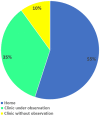Determinants of intermittent preventive treatment of malaria among women attending antenatal clinics in primary health care centers in Ogbomoso, Oyo State, Nigeria
- PMID: 31489079
- PMCID: PMC6713488
- DOI: 10.11604/pamj.2019.33.101.14800
Determinants of intermittent preventive treatment of malaria among women attending antenatal clinics in primary health care centers in Ogbomoso, Oyo State, Nigeria
Abstract
Introduction: Despite the effectiveness of intermittent preventive treatment in pregnancy using sulphadoxine-pyrimethamine (IPTp-SP), the uptake and coverage in southwest Nigeria are low. We assessed the factors influencing utilisation of IPTp-SP.
Methods: A multistage sampling technique was used to select 400 pregnant women from six primary healthcare centers in Oyo State. Data on socio-demographic characteristics, knowledge, attitude towards IPTp-SP and its utilisation were obtained using a semi-structured questionnaire. Data were analyzed using SPSS software. Focus group discussions (FGD) and key informant interviews (KII) were held for pregnant women and healthcare workers and analysed thematically.
Results: Mean age of respondents was 27.2 (SD ± 5.5) years. Mean gestational age was 29.5 weeks (SD ± 5.4). Overall, 320 (80.0%) took SP, of which 152 (47.5%) took 2 doses and 112 (35.0%) took under directly observed therapy (DOT). We found that early booking for ANC, more than two visits to ANC (adjusted odds ratio (aOR) = 5.6; 95% CI: 1.2 - 26.6), good knowledge on IPTp (aOR = 9.3; 95% CI: 5.4 - 16.0), positive attitude towards IPTp (aOR = 2.1; 95% CI: 1.5 - 2.9) and being employed (aOR = 1.4; 95% CI: 1.1 - 1.7) were factors associated with IPTp-SP utilisation. The FGD and KII revealed that IPTp-SP drugs were mostly taken at home due to stock out.
Conclusion: Late ANC booking with stock out of IPTp-SP drugs was responsible for its low utilisation. There is need to encourage pregnant women to book early for ANC. Adherence to the practice of DOT scheme is recommended to improve IPTp-SP utilisation.
Keywords: Malaria; intermittent preventive treatment; knowledge; pregnancy; primary healthcare centres.
Conflict of interest statement
The authors declare no competing interests.
Figures
Similar articles
-
Factors affecting uptake of ≥ 3 doses of Sulfadoxine-Pyrimethamine for malaria prevention in pregnancy in selected health facilities, Arusha region, Tanzania.BMC Pregnancy Childbirth. 2019 Nov 27;19(1):440. doi: 10.1186/s12884-019-2592-0. BMC Pregnancy Childbirth. 2019. PMID: 31775686 Free PMC article.
-
Socio-demographic and regional disparities in utilization of intermittent preventive treatment for malaria in pregnancy - Nigeria demographic health survey 2013.Pan Afr Med J. 2019 Jan 25;32(Suppl 1):13. doi: 10.11604/pamj.supp.2019.32.1.13345. eCollection 2019. Pan Afr Med J. 2019. PMID: 30949287 Free PMC article.
-
Predictors for the uptake of optimal doses of sulfadoxine-pyrimethamine for intermittent preventive treatment of malaria during pregnancy in Tanzania: further analysis of the data of the 2015-2016 Tanzania demographic and health survey and malaria indicator survey.Malar J. 2021 Feb 6;20(1):75. doi: 10.1186/s12936-021-03616-2. Malar J. 2021. PMID: 33549094 Free PMC article.
-
Community-based strategies to increase coverage of intermittent preventive treatment of malaria in pregnancy with sulfadoxine-pyrimethamine in sub-Saharan Africa: a systematic review, meta-analysis, meta-ethnography, and economic assessment.Lancet Glob Health. 2024 Sep;12(9):e1456-e1469. doi: 10.1016/S2214-109X(24)00228-6. Lancet Glob Health. 2024. PMID: 39151981
-
Safety and toxicity of sulfadoxine/pyrimethamine: implications for malaria prevention in pregnancy using intermittent preventive treatment.Drug Saf. 2007;30(6):481-501. doi: 10.2165/00002018-200730060-00003. Drug Saf. 2007. PMID: 17536875 Review.
Cited by
-
Late ANC initiation and factors associated with sub-optimal uptake of sulphadoxine-pyrimethamine in pregnancy: a preliminary study in Cape Coast Metropolis, Ghana.BMC Pregnancy Childbirth. 2021 Feb 2;21(1):105. doi: 10.1186/s12884-021-03582-2. BMC Pregnancy Childbirth. 2021. PMID: 33530957 Free PMC article.
-
Barriers and facilitators to access and uptake of intermittent preventive treatment with sulfadoxine-pyrimethamine among pregnant women in Nigeria: a scoping review.Malariaworld J. 2022 Feb 1;13:4. eCollection 2022. Malariaworld J. 2022. PMID: 35813271 Free PMC article.
-
Bridging urban-rural disparities in malaria care during pregnancy in Senegal: evidence from household and health facility surveys.Infect Dis Poverty. 2025 Jul 20;14(1):71. doi: 10.1186/s40249-025-01341-5. Infect Dis Poverty. 2025. PMID: 40684198 Free PMC article.
-
Antenatal care positive responses to pregnant women in preventing and controlling malaria in pregnancy: the sub-Saharan African perspective.World J Pediatr. 2022 Jul;18(7):453-462. doi: 10.1007/s12519-022-00549-x. Epub 2022 May 26. World J Pediatr. 2022. PMID: 35616810 Review.
-
Eye Health-seeking Behaviour of Traders in Rural Nigeria.J West Afr Coll Surg. 2022 Apr-Jun;12(2):7-11. doi: 10.4103/jwas.jwas_62_22. Epub 2022 Aug 27. J West Afr Coll Surg. 2022. PMID: 36213809 Free PMC article.
References
-
- World Health Organization . World Malaria Report. Geneva: 2016.
-
- Desai M, ter Kuile FO, Nosten F, McGready R, Asamoa K, Brabin B, et al. Epidemiology and burden of malaria in pregnancy. Lancet Infect Dis. 2007;7(2):93–104. - PubMed
-
- Steketee RW, Nahlen BL, Parise ME, Menendez C. The burden of malaria in pregnancy in malaria-endemic areas. Am J Trop Med Hyg. 2001;64(1-2):28–35. - PubMed
-
- Ekejindu I, Udigwe G, Chijoke I. Malaria and anemia in pregnancy in Enugu, southeast Nigeria. Afri J Med Sci. 2006;35(1):1–3. - PubMed
-
- World Health Organization . A strategic framework for malaria prevention and control during pregnancy in the Africa region. Geneva, Switzerland: 2004.
MeSH terms
Substances
LinkOut - more resources
Full Text Sources
Medical


